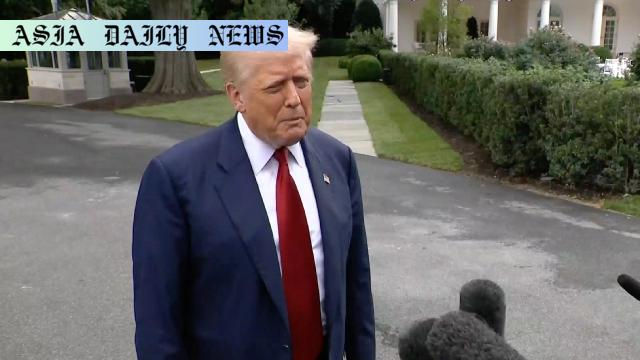Submarines: US President Trump orders deployment of two nuclear submarines in response to Medvedev’s provocative comments.
- US President Trump ordered nuclear submarine deployments citing Medvedev’s comments.
- The move aims to pressure Russia and ensure US preparedness against nuclear threats.
- Special envoy Steve Witkoff to visit Russia before the ceasefire deadline.

Trump’s Strategic Submarine Deployment
In a significant and unprecedented decision, US President Donald Trump has ordered the deployment of two nuclear-powered submarines to undisclosed “appropriate regions” in a move that underscores the heightened tensions between the United States and Russia. This directive was reportedly made in response to “highly provocative” statements from Dmitry Medvedev, Russia’s former president and current deputy chair of its security council. By positioning these submarines, Trump emphasized the crucial need for US preparedness in the face of potential nuclear threats, reflecting a strategy aimed at safeguarding American interests and global stability.
The Catalyst: Medvedev’s Comments
Medvedev’s remarks seemingly played a pivotal role in prompting Trump’s decision. On social media, the Russian official accused Trump of “playing the ultimatum game with Russia,” signaling rising hostilities between the two nations. Medvedev also hinted at the possibility of nuclear retaliation, escalating fears of a broader conflict. While the comments themselves lack full transparency, they have intensified suspicions around Russia’s intent and its potential response to US measures such as these new submarine deployments. Trump’s interpretation of the Russian leader’s statements as a direct threat reflects his administration’s willingness to employ assertive military posturing in response to geopolitical adversities.
Ceasefire Efforts and Diplomatic Intentions
Alongside strategic military preparations, Trump has also focused on diplomacy. Special envoy Steve Witkoff has been tasked with visiting Russia ahead of an August 8 deadline set by the US for Moscow to agree on a ceasefire deal with Ukraine. This dual-strategy approach—combining military deterrence with diplomatic outreach—seeks to pressure Moscow into concessions. However, the effectiveness of this strategy remains to be seen amidst the backdrop of strained US-Russia relations, with critics raising concerns over the potential for military escalation if diplomacy fails to yield results.
Implications for Global Security
This latest move by the US has significant ramifications for global security. Deploying nuclear power overseas naturally heightens the risk of unintended consequences, especially when major powers like the US and Russia are involved. Furthermore, such deployments could send ripples across NATO allies, potentially altering existing strategies for collective security. Trump’s focus on nuclear preparedness, while aimed at protecting American interests, underscores the fragile dynamics of global geopolitics where each aggressive move could lead to a broader confrontation. Experts caution that nuclear posturing, while necessary in terms of deterrence, must be matched with equally strong diplomatic engagement to maintain overall equilibrium.
The Broader Context of US-Russia Relations
The current situation opens a fresh chapter in the already contentious relationship between the US and Russia. With both countries possessing vast nuclear arsenals, their interactions naturally hold implications for wider international stability. As the conflict in Ukraine continues to rage, both powers have ramped up their rhetoric and retaliatory measures, making diplomatic resolutions increasingly elusive. Trump’s deployment of submarines clearly showcases America’s intent to lead with strength. However, whether this show of power will translate into substantive resolution or merely exacerbate existing tensions remains a key question moving forward.



Commentary
The Strategic Importance of Trump’s Decision
President Trump’s decision to deploy two nuclear-powered submarines highlights a critical moment in US foreign policy, particularly in the arena of US-Russia relations. This move reflects a calculated response to what is seen as escalating threats from Russia, underscoring Trump’s emphasis on military preparedness and deterrence. By signaling strength and readiness, the deployment serves as both a warning to Moscow and reassurance to American allies. However, such actions must be weighed carefully, given the risks of misunderstandings or unintended escalations.
The Risks of Escalation
Deploying nuclear assets is never a decision to be taken lightly. While the intention might be to deter further provocations, such moves can also escalate an already tense situation. Medvedev’s comments, deemed “provocative” by Trump, could be further exacerbated by the submarine deployments, potentially leading to retaliatory displays of power by Russia. The thin line between readiness and provocation serves as a reminder of the delicate nature of international relations, where any missteps could have severe consequences. It is essential for all parties involved to exercise caution and restraint.
The Balance Between Power and Diplomacy
Trump’s decision to deploy submarines is a prime example of combining hard power with diplomatic efforts. While military strength showcases America’s resolve, appointing special envoy Steve Witkoff for ceasefire negotiations demonstrates a willingness to pursue peaceful resolutions. This dual approach reflects a nuanced strategy—one that seeks to balance strength with dialogue. However, the success of such strategies is contingent on the willingness of both parties to engage constructively, a challenging prospect in the current geopolitical climate.
The Need for Collaboration and Foresight
Ultimately, the deployment of nuclear submarines and the ongoing tensions between the US and Russia underline the pressing need for robust international collaboration. Global security is not a solitary endeavor; it requires collective effort and foresight. While national interests often dominate decision-making, leaders must remain cognizant of their broader responsibility to maintain peace and stability. Actions such as these should go hand-in-hand with open channels of communication, fostering trust and reducing the potential for conflict. In this delicate geopolitical landscape, measured steps and wise decisions are paramount.